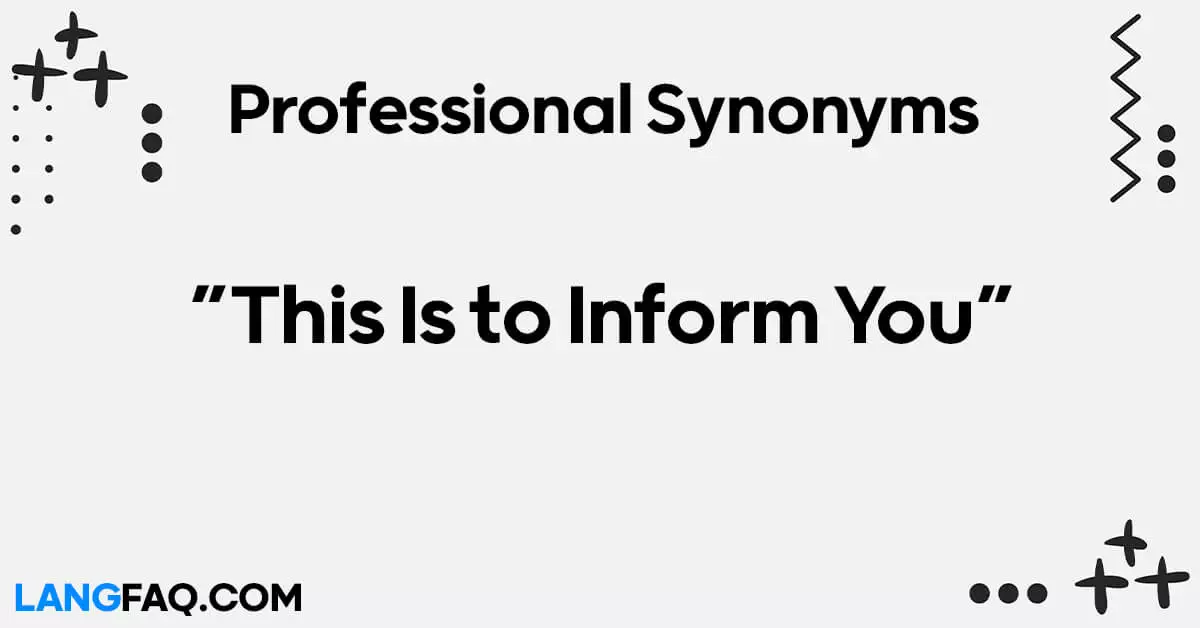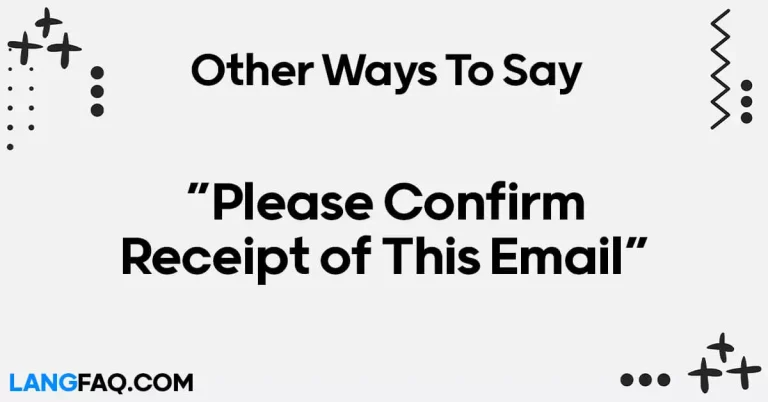“This Is to Inform You” is a phrase commonly used in business communication to convey important information or updates to a recipient. It is often used at the beginning of an email or letter to immediately inform the reader of the purpose of the communication.
In the professional world, the way we communicate is crucial as it reflects our integrity and competence. Using clear, concise, and professional language is essential in building and maintaining strong relationships with clients, colleagues, and superiors. Therefore, it is important to use professional language, even when starting a sentence with “This Is to Inform You.”
Here are 12 professional ways to say “This Is to Inform You” in your business communication:
- “I would like to bring to your attention…”
- “I would like to update you on…”
- “I am writing to inform you that…”
- “I wanted to let you know that…”
- “I am reaching out to inform you that…”
- “I am pleased to inform you that…”
- “I have some news to share with you…”
- “I am writing to advise you that…”
- “I wanted to notify you that…”
- “I am sending this email to inform you that…”
- “I have an update for you regarding…”
- “I am providing you with an update on…”
By using these professional alternatives, you can effectively convey your message while maintaining a polished and respectful tone in your communication.
Key Takeaways:
Using professional language in business communication is crucial for conveying a sense of competence and credibility. There are many different ways to say “this is to inform you” in a formal setting, such as “bringing to your attention” or “updating you on”.
The key factors contributing to the success of companies, like Begbies Traynor, include their use of formal language choices and providing information effectively.
Is It Professional to Say “This Is to Inform You”?
The phrase “This Is to Inform You” is certainly formal and appropriate in specific situations. However, whether it is considered truly professional depends on the context and the relationship between the parties involved. Let’s delve into the nuances of using this phrase in professional communication.
When It’s Professional:
- Official Notifications: In formal written documents, such as official letters, emails, or legal notices, “This Is to Inform You” is entirely professional. It sets a formal tone and leaves no room for ambiguity. For example, when informing a client of a change in contractual terms, this phrase is suitable.
- Corporate Announcements: Within a corporate setting, especially in internal communications, using this phrase can be considered professional. It adds a layer of formality to announcements, such as policy changes, restructuring, or important updates.
- Academic or Research Communication: In academic or research contexts, when notifying colleagues or peers about significant findings or updates, this phrase is entirely appropriate. It maintains the seriousness of the message.
When It Might Not Be Professional:
- Everyday Conversations: In casual, day-to-day interactions with colleagues or team members, using “This Is to Inform You” might come across as overly formal and unnecessarily rigid. It’s important to strike the right tone based on the relationship and the nature of the communication.
- Client-Focused Communication: While formal language has its place, it’s essential to consider the client’s preference. Some clients may appreciate a more straightforward and conversational style. Gauge the client’s expectations and adapt your communication accordingly.
- Internal Team Communication: Within a close-knit team, overly formal language might create a sense of distance. Opt for a tone that fosters open and transparent communication to maintain a positive team dynamic.
Pros of Using “This Is to Inform You”:
- Clarity: It leaves no room for misunderstanding, making it suitable for conveying critical information.
- Formality: In formal contexts, it sets the right tone and conveys the seriousness of the message.
- Standardization: In certain industries or professions, using formal phrases like this one is a standard practice, ensuring consistency in communication.
Cons of Using “This Is to Inform You”:
- Rigidity: It can make the communication seem rigid and impersonal, which might not be suitable for all situations.
- Distance: In some cases, it can create a sense of distance between the sender and the recipient, which could hinder open communication.
- Lengthy: The phrase itself is somewhat lengthy, and in today’s fast-paced digital communication, brevity is often preferred.
In conclusion, while “This Is to Inform You” has its place in professional communication, its appropriateness depends on the specific situation and the relationship between the parties involved. Consider the context, tone, and the preferences of your audience when deciding whether to use this phrase or opt for a more conversational approach. In professional communication, clarity and respect for the recipient’s expectations should always be your guiding principles.
What Does “This Is to Inform You” Mean?
“What Does “This Is to Inform You” Mean?” is a formal phrase used to convey a message or provide information. It is commonly used in written communication such as emails, letters, or official announcements.
This phrase serves as an introductory statement indicating that the following content is meant to inform the recipient about something specific. It is a polite way of notifying someone about a matter or updating them on a particular situation.
In a similar tone, an example of a true historical event related to communication is the delivery of the first transatlantic telegraph message in 1858. This significant milestone allowed for instantaneous communication between North America and Europe, transforming the way information was shared globally.
Why Is It Important to Use Professional Language in Business Communication?
Using professional language in business communication is crucial for a variety of reasons.
- Clarity: Professional language ensures that your message is easily understood by the recipient.
- Credibility: Using professional language enhances your credibility and portrays you as knowledgeable and competent in your field.
- Respect: It demonstrates respect for the recipient and the business relationship you have with them.
- Avoidance of misunderstandings: Professional language helps prevent misinterpretations and misunderstandings that can arise from using informal or ambiguous language.
- Professional image: Using professional language helps to uphold a professional image for yourself and your company.
Overall, it is of utmost importance to use professional language in business communication for effective and successful interactions.
12 Professional Ways to Say “This Is to Inform You”
In professional communication, it is important to use clear and concise language to convey information. Instead of using the common phrase “this is to inform you”, there are various other ways to effectively communicate the same message.
In this section, we will discuss 12 professional ways to say “this is to inform you” in order to enhance your written and verbal communication skills.
Each phrase will provide a different tone and level of formality, allowing you to choose the most appropriate one for your specific situation.
- “I wish to bring to your attention”: This phrase implies a sense of importance and urgency. It signals that the information you’re about to share demands immediate consideration.
- “I’m writing to inform you”: A direct and clear way to convey your message professionally. It’s a classic choice for formal communication.
- “I’d like to apprise you of”: This phrase suggests that you’re providing valuable information, and it conveys a sense of responsibility.
- “I have the pleasure of informing you”: Use this phrase when you want to share positive news or updates. It adds a touch of optimism to your message.
- “Allow me to bring to your notice”: This is a polite and respectful way to introduce important information. It shows your consideration for the recipient.
- “I want to make you aware that”: A straightforward way to convey your message while maintaining professionalism. It’s especially useful in business communication.
- “Kindly be advised that”: Use this phrase when you want to give clear instructions or guidance. It implies a sense of authority.
- “It is my duty to inform you”: This phrase emphasizes your responsibility in delivering the information. It’s suitable for formal announcements.
- “I’m reaching out to let you know”: A friendly and approachable way to convey information. It’s ideal for internal communication within a team.
- “May I inform you that”: A polite and formal way to share important updates. It shows your respect for the recipient.
- “I wanted to make sure you’re aware”: This phrase conveys a sense of care and consideration. It’s suitable for delivering news to colleagues or friends.
- “Permit me to notify you”: This formal expression indicates a sense of permission, making it appropriate for professional announcements.
1. “I would like to bring to your attention…”
“I would like to draw your attention to…” is a professional way to inform someone about an important matter. It is commonly used in formal business communication to highlight a specific issue or topic that requires attention.
This phrase helps to focus the recipient’s attention and emphasizes the significance of the information being shared. By using this phrase, you can effectively convey the importance of the matter at hand and ensure that it receives the necessary consideration.
2. “I would like to update you on…”
When communicating in a professional setting, it is important to use professional language to convey information effectively. One professional way to express the same sentiment as “I would like to update you on” is by using phrases such as “I have an update for you regarding” or “I am providing you with an update on.”
These phrases maintain a formal tone and clearly convey the purpose of the communication. By utilizing such language, clarity and professionalism are ensured in business communication.
3. “I am writing to inform you that…”
When communicating in a formal setting, there are various professional ways to say “I am writing to inform you that…” Here are 12 alternatives:
- “I would like to bring to your attention…”
- “I would like to update you on…”
- “I am reaching out to inform you that…”
- “I wanted to let you know that…”
- “I am writing to advise you that…”
- “I am pleased to inform you that…”
- “I have some news to share with you…”
- “I wanted to notify you that…”
- “I am sending this email to inform you that…”
- “I have an update for you regarding…”
- “I am providing you with an update on…”
- “I am writing to inform you that…”
4. “I wanted to let you know that…”
- “I wanted to inform you that…”
5. “I am reaching out to inform you that…”
“I am contacting you to inform you that…” is a professional and effective way to convey information in business communication. This phrase indicates that the sender is proactively reaching out to provide important information. It demonstrates a proactive and respectful approach, emphasizing clear and direct communication.
By using this phrase, the sender is taking ownership of the communication and ensuring that the recipient is informed in a timely manner.
This phrase is particularly useful when providing updates, sharing news, or delivering important announcements. It sets a professional tone and shows that the sender values open and transparent communication.
6. “I am pleased to inform you that…”
When delivering positive news or updates in formal settings, incorporating phrases like “I am pleased to inform you that…” can effectively convey professionalism and courtesy. This phrase signifies a positive and significant announcement, setting a favorable tone for the message. It reflects your enthusiasm and builds anticipation for the recipient. It is important to maintain a formal tone and use appropriate language choices to enhance the impact of your message.
Pro-tip: Make sure that the information you are sharing is truly positive and relevant to the recipient, as false or irrelevant announcements can damage your credibility.
7. “I have some news to share with you…”
When you need to convey information to someone in a formal setting, you can use the professional phrase “I have some news to share with you…” to initiate the conversation. This phrase effectively conveys that you have important information to communicate.
It sets a professional tone and demonstrates that you value open and transparent communication. Using this phrase in business communication shows that you are proactive and dedicated to keeping others informed. It is a courteous and respectful way to deliver updates or important information to colleagues, clients, or superiors.
8. “I am writing to advise you that…”
When utilizing professional language in business communication, it is crucial to effectively convey information and maintain a formal tone. One effective way to do so is by incorporating the phrase “I am writing to advise you that…” This phrase clearly indicates that the purpose of the communication is to provide guidance or recommendations.
By using this professional language, you convey a sense of authority and expertise. It is imperative to be concise and direct in your message to ensure that the recipient fully comprehends the advice being given. Additionally, it is important to consistently maintain a respectful and professional tone throughout the communication.
9. “I wanted to notify you that…”
When communicating information formally, it is appropriate to use the phrase “I wanted to notify you that…” in order to maintain a professional and clear tone. This phrase is particularly effective in business communication as it clearly conveys the purpose of the message.
For instance, if there is a change in a project deadline that needs to be communicated to a colleague, one can say, “I wanted to notify you that the project deadline has been extended by two days.” By using this phrase, a formal tone is established while ensuring that the recipient understands the intention of the message.
It is important to remember that clear and concise communication is essential in professional environments as it helps to avoid misunderstandings and promotes effective collaboration.
10. “I am sending this email to inform you that…”
When sending an email to inform someone about something, it’s important to be clear, concise, and professional. Here are some steps to follow:
- Start with a clear subject line that summarizes the message.
- Greet the recipient in a professional manner, using their name.
- Provide a brief introduction and state the purpose of the email, such as “I am sending this email to inform you that…”.
- Include relevant details and information, keeping the message focused and organized.
- Use a polite and professional tone throughout the email.
- End the email with a clear call to action or next steps.
- Closing the email with a polite closing phrase, such as “Thank you” or “Best regards”.
- Proofread the email for any errors before hitting the send button.
11. “I have an update for you regarding…”
When providing updates in a professional setting, it is important to use language that conveys the appropriate tone and level of formality. Instead of using the phrase “I have an update for you regarding…”, consider these alternatives:
- “I would like to provide you with an update on…”
- “I wanted to inform you of the latest developments regarding…”
- “This is to update you on the progress of…”
- “I am reaching out to share an update with you regarding…”
- “I am pleased to inform you about the recent updates concerning…”
Remember to choose the option that best fits the context and purpose of your communication.
12. “I am providing you with an update on…”
When communicating in formal settings, it is important to use professional language to convey information effectively. One professional way to say “I am providing you with an update on…” is by using phrases like “I am giving you the latest information regarding…” or “I am sharing an update on the status of…”.
These alternatives maintain a formal tone while ensuring clarity and professionalism in business communication. By using precise and concise language, you can effectively convey updates and keep your audience informed in a professional manner.
Give Information
When providing information, it’s important to use clear and professional language. Here are 12 alternative phrases to say “This is to inform you”:
- I wanted to let you know…
- I’m reaching out to share…
- It has come to my attention that…
- I thought it would be important to inform you…
- I’d like to update you on…
- This message is to give you information regarding…
- I’m writing to provide you with…
- Allow me to share the following details…
- I wanted to bring to your attention…
- It is my duty to inform you that…
- I wanted to make sure you are aware that…
- This is a formal notice to let you know…
Pro-tip: When giving information, be concise and use bullet points or numbered lists to make it easier for the reader to understand and process the information.
Formal Settings
In formal settings, it is crucial to utilize professional language when conveying information. Instead of using the phrase “This is to inform you,” consider utilizing these alternatives:
- “I am writing to notify you”
- “I would like to bring to your attention”
- “I wanted to update you on”
- “Please be advised that”
- “I am reaching out to inform you”
- “I wanted to inform you that”
- “This is a formal notice to”
- “I am sharing this information to”
- “I am writing to let you know”
- “I wanted to make you aware that”
- “I am bringing this matter to your attention”
- “Kindly be informed that”
Using these phrases will help maintain a professional tone in formal settings.
Preferred Version
When it comes to communicating in a professional setting, there are various ways to express the idea of “This is to inform you.” Here is a preferred version of conveying the same message:
- “I wanted to make you aware of…”
- “I am reaching out to let you know…”
- “This email is intended to notify you that…”
- “I thought it important to inform you that…”
- “I am writing to update you on…”
Pro-tip: Instead of using a generic phrase, personalize your communication by providing specific information right away, such as the purpose or key details of the update.
Formal Language Choices
When using formal language choices to convey the message “This is to inform you,” it is important to carefully choose your words. Here are 12 professional alternatives that can be used in different contexts:
- “I am writing to notify you…”
- “I wish to bring to your attention that…”
- “Please be advised that…”
- “I wanted to inform you that…”
- “I would like to inform you that…”
- “It is my duty to inform you that…”
- “I am pleased to inform you that…”
- “Per our previous discussion, I wanted to let you know that…”
- “I would like to update you on the following matter…”
- “I would like to draw your attention to the fact that…”
- “This correspondence aims to inform you that…”
- “I felt it necessary to inform you that…”
These alternatives can help you maintain a professional tone while effectively conveying your message.
Key Factors Contributing to Begbies Traynor’s Success
Begbies Traynor’s success can be attributed to several key factors:
- Expertise: Their team of professionals possess extensive knowledge and experience in their respective fields.
- Reputation: Begbies Traynor has built a strong reputation for delivering high-quality services and achieving favorable outcomes for clients.
- Client-centered approach: They prioritize understanding client needs and providing tailored solutions.
- Strong network: Their extensive network enables them to access valuable resources and opportunities.
- Adaptability: They stay ahead of market trends, adapting their strategies to meet changing demands.
- Innovation: By embracing technology and innovative solutions, Begbies Traynor is able to streamline processes and enhance efficiency.
These factors have contributed significantly to Begbies Traynor’s continued success and position as a leading firm in their industry. Companies looking to achieve success should consider prioritizing expertise, building a strong reputation, focusing on client needs, fostering a strong network, being adaptable, and promoting innovation.
Frequently Asked Questions
What are some formal options for saying “this is to inform you” in emails?
Some great ways to mix things up and avoid sounding repetitive include “I am writing to let you know,” “Just to let you know,” and “I am writing to inform you.”
Why is “this is to inform you” somewhat redundant in corporate cases?
In formal contexts, “this is to inform you” can be considered a decent phrase to add severity to the message. However, in corporate cases, using phrases like “I am writing to inform you” or “I am writing to let you know” is a better way to convey new information without being overly formal.
What are some alternatives to “this is to inform you” in business contexts?
Some less redundant phrases that can be used in business contexts include “I am writing to tell you,” “This is to let you know,” and “Just so you know.” These phrases convey new information without being too formal.
When is “I am writing to let you know” the only way to convey new information?
In high alert or urgent situations, “I am writing to let you know” is the best synonym to use. This phrase adds a serious tone and shows that the recipient needs to pay attention and take necessary action.
Is it recommended to use “just saying” in formal emails?
No, “just saying” is a more casual alternative and is best used in more informal contexts, such as emails to colleagues or friends. In formal emails, it is better to use phrases like “I am writing to inform you” or “Just to let you know.”
Can “I am writing to let you know” be used as a polite way to demand someone’s attention?
Yes, “I am writing to let you know” is a polite and formal way to demand someone’s attention without being too bossy or direct. It is a good option to use when there is a need for the recipient to take further action or be updated about something.







